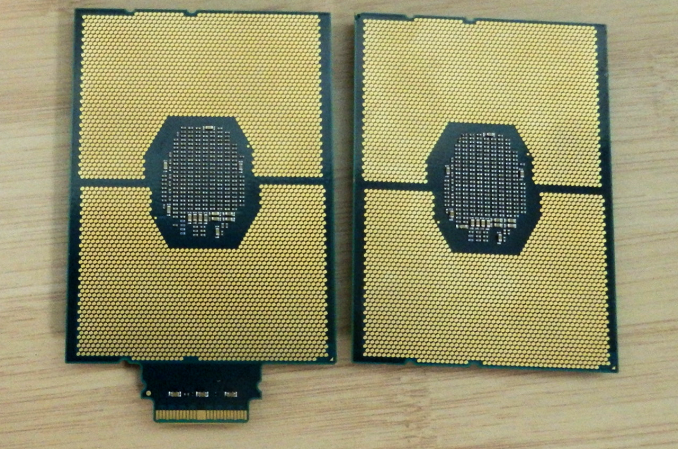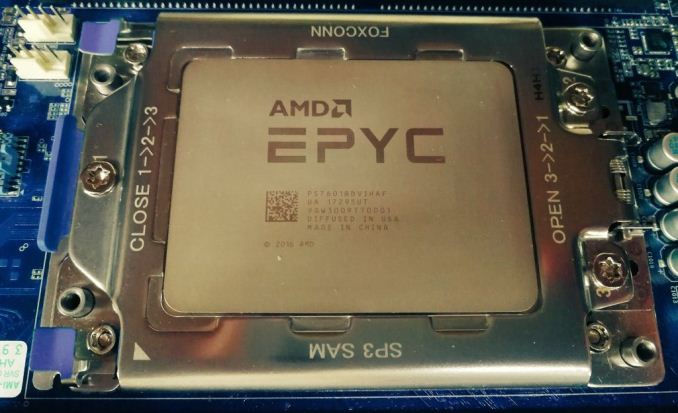Dissecting Intel's EPYC Benchmarks: Performance Through the Lens of Competitive Analysis
by Johan De Gelas & Ian Cutress on November 28, 2017 9:00 AM EST- Posted in
- CPUs
- AMD
- Intel
- Xeon
- Skylake-SP
- Xeon Platinum
- EPYC
- EPYC 7601
Conclusion
First of all, Intel's benchmarks lend further support to what we already suspected: Intel's Scalable Xeon is better at serving databases for a number of reasons: better data locality (fewer NUMA nodes), better single-threaded performance, and a more "useable" cache. The claim that Intel offers much more predictable database performance seems very reasonable to us: the EPYC platform is much younger and much more complex to tune as it is a "virtual 8 socket" system.
Secondly it is true that the Intel Scalable Xeon is more versatile: the past 5 years AMD's presence in the server market was neglible, while Intel has been steadily adding virtualization features (posted interrupts), I/O features and more (TSX for example). Many of these features are now supported by the hypervisor and OSes out there.
The EPYC platform has some catching up to do. Firmware updates and other software updates were necessary to run a hypervisor, and only relatively recent versions of the Linux kernel (February 2017 w/4.10+) have support for the EPYC processor. So even if we doubt that the 8160 can really deliver 37% better performance than the AMD EPYC in the real world, there is no denying that the Intel Xeon is a "safer bet" for VMware virtualization.
Nevertheless, it is interesting to see that Intel admits that there are quite a few use cases out there where AMD has an advantage. The AMD EPYC has a performance per dollar advantage in webserving and Java servers, for example.
Otherwise, there is some merit to the claim that AVX-512 allows Intel to offer excellent HPC performance without the use of a GPU in compute intensive applications. At the same time, if you are after the best performance on these very parallel workloads, a GPU almost always offers several times higher performance. AVX-512 can also not save Intel in several bandwidth-intensive benchmarks such, as in fluid dynamics.

Intel Xeon-SP CPUs (Left: with Omni-Path)
One interesting element to the whole scenario is that at no point does Intel ever approach the performance per watt angle in these discussions. It leaves a big question unanswered from Intel - perhaps we should invoke Hanlon's Razor at this point and call it a missed opportunity, rather than suggest that Intel does not want to speak about power. Our own results showed a win for AMD's EPYC here though, when comparing two 145W Xeon 8176 parts to two 180W EPYC 7601 parts. More testing on specific workloads is needed.
In summary, Intel makes several good points, even when those points aren't always in their own favor. The company clearly has an interest in ensuring that the Xeon's performance leadership remains well-known in light of AMD's EPYC-fueled resurgence, and while there's nothing altruistic about Intel's benchmarking, they are working from a sound position. Still, in defending their position – and by extension their high margins – Intel does highlight the Xeon's biggest weakness versus the EPYC in this newly competitive market: the Skylake Xeon can offer excellent performance, but that performance comes with an equally heavy price tag.

















105 Comments
View All Comments
piesquared - Tuesday, November 28, 2017 - link
And the hilarity continues. So AMD posts in house benchmarks and the crowd goes: Derp, these are AMD supplied benchmarks, best wait for third party benchmarks.Intel posts in house benchmarks and the crowd goes: Wow awesome dude, that's the shitsors! Who needs third party benchmarks, AMD should post more in house benchmarks. derp derp
tamalero - Tuesday, November 28, 2017 - link
Guerrilla marketing at its finest? The hilarity is that when Intel was dominating.. they never mentioned intel nor they needed.Now that AMD has a compelling product. They suddenly started doing "comparisons" left and right and claiming how bad "glue" is in AMD cpus (while ignoring the drama bout using cheap TIM instead of solder)
bmf614 - Tuesday, November 28, 2017 - link
Epyc really hasnt even launched yet. Try buying a Dell or HP with Epyc. Nope.supdawgwtfd - Wednesday, November 29, 2017 - link
It's launched. Demand has outstripped supply. They are now starting to get on top of it.Maybe stop being an Intel biased dickhead and go look at what is actually happening?
Topweasel - Wednesday, November 29, 2017 - link
Yeah, I don't get it. I mean even Ryzen mobile launched well before we saw it. Eypc announcement early was important to build up demand with OEM's. Something that wasn't as important with a consumer product that needed announcement with availability. EPYC's announcement wasn't for the end purchaser. Both these need long testing periods and seed supply. Epyc then has ODM builds for cloud services that they have supply. Ryzen mobile launched when OEM's had products to ship. EPYC launched when they products to ship to manufacturers. When those Manufacturers offered EPYC depends completely on their development cycle.Johan Steyn - Monday, December 18, 2017 - link
Haha so trueNinhalem - Tuesday, November 28, 2017 - link
Can we get ANSYS Structural or Comsol benchmarks for the HPC sections? Building machines using Xeons for these applications is beyond expensive for engineering design on fixed price contracts.anactoraaron - Tuesday, November 28, 2017 - link
No, because AT didn't test anything here. They are just 'publishing' Intel's benchmarks and calling it an 'analysis'.Doesn't this qualify for the #ad in the title?
Ryan Smith - Wednesday, November 29, 2017 - link
To throw some context in here, the purpose of this article isn't to publish Intel's benchmarks. Rather, it's commentary on what has been a very unusual situation.Up until now, neither AMD nor Intel have engaged in any serious Skylake Xeon vs. Zen EPYC technical marketing.
"AMD's technical marketing of the new CPU has been surprisingly absent, as the company not published any real server benchmarks. The only benchmarks published were SPEC CPU and Stream, with AMD preferring for its partners and third parties to promote performance"
This despite the fact that AMD and Intel's server products haven't been competitive like this in nearly a decade. Normally you'd expect there to be case studies flying out left and right, which has not been the case. And it's especially surprising since, as the underdog, AMD needs to claw back lost ground.
Consequently, Intel's own efforts are, to date, the first efforts by a server vendor to do a comprehensive set of benchmarks over a range of use cases. And let's be clear here: this is Intel doing this for Intel's own benefit. Which is why we've already previously reviewed the two CPUs, as have other 3rd party groups.
Still, I think it's very interesting to look at what Intel has chosen to represent, and what their numbers show. Intel has more resources than pretty much everyone else when it comes to competitive analysis, after all. So their choices and where they show themselves falling behind AMD says a lot about the current situation.
(And no, this doesn't quality for #ad as Intel hasn't paid us. That's not how this works; that's not how any of this works)
deltaFx2 - Wednesday, November 29, 2017 - link
@Ryan Smith: "Up until now, neither AMD nor Intel have engaged in any serious Skylake Xeon vs. Zen EPYC technical marketing." I think that's largely because the market is different from a decade ago. Hyperscalers do their own testing and aren't swayed by Intel's or AMD's whitepapers. They do their own thing. There are still many companies that buy and maintain their own servers, but my understanding is that this market is shrinking or at least not growing. Cloud is where the money is, and they know what they want. I don't think AMD is trying to go after enterprise this time around (I'm sure they'll take their business but the main target seems to be hyperscalers. The CCX, MCM, large memory footprint etc all point to them saying we'll target scale-out as opposed to scale-up. AMD does quite well in scale-out, while taking a hit in scale-up.).Also, AMD might still be in the process of doing minor firmware tweaks as evidenced by tier-1 server availability (HP/Dell) coming online only end of Q4.